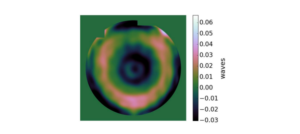A. M. Michalko and J. R. Fienup
in the proceedings of the joint ASPEN (Asian Society for Precision Engineering and Nanotechnology)/ASPE (American Society for Precision Engineering) Spring Topical Meeting on the “Manufacture and Metrology of Structured and Freeform Surfaces for Functional Applications,” Hong Kong, March 2017.

Transverse Translation Diverse Phase Retrieval (TTDPR), a wavefront sensing technique similar to ptychography, is a viable method for measuring highly aberrated wavefronts produced by freeform optical surfaces. In TTDPR, a subaperture illumination pattern is translated across an optical field of interest, and, for each translated position, intensity is measured with an array detector in a distant, often near-focus, plane [1, 2]. The ensemble of measured intensity distributions is used in a joint-estimation algorithm, typically using non- linear optimization, to estimate wavefront aberration in the field of interest. Other relevant parameters such as the field amplitude and imperfectly known illumination pattern may be reconstructed as well. From this wavefront measurement, meaningful metrological information, such as surface topography, may be inferred. TTDPR requires a relatively simple and compact experimental arrangement consisting of an optical field under test, a translating subaperture, and a detector. Unlike conventional interferometric techniques, TTDPR does not suffer from retrace errors, nor does it require reference or nulling optics. Additionally, TTDPR has reduced sensitivity to vibration compared with an interferometer [3]. It is therefore a relatively inexpensive, yet accurate solution for aspheric and freeform optical metrology.


